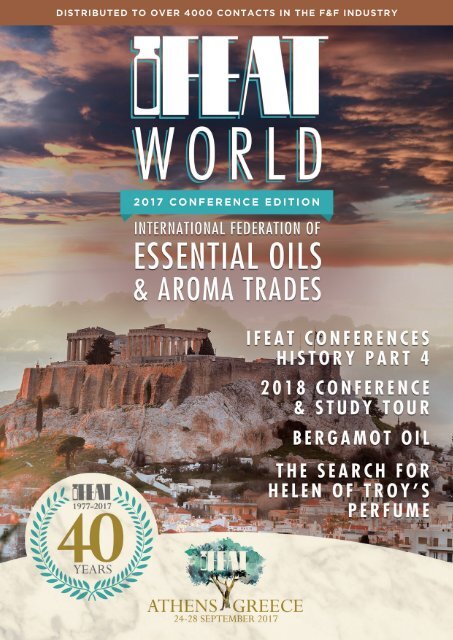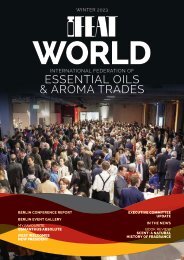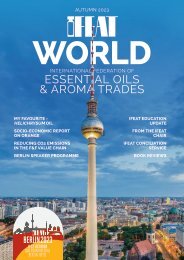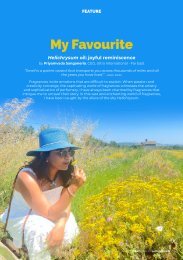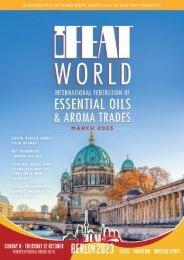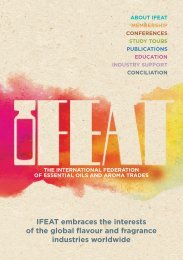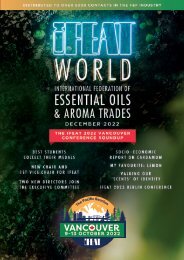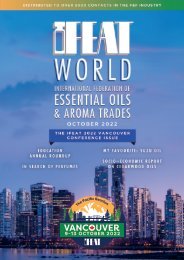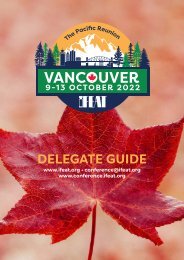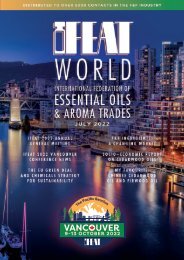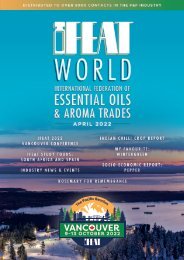Create successful ePaper yourself
Turn your PDF publications into a flip-book with our unique Google optimized e-Paper software.
WORLD 3<br />
ATHENS<br />
GREECE<br />
24-28 SEPTEMBER <strong>2017</strong><br />
FROM THE CONFERENCE CHAIRMAN<br />
DOMINIQUE ROQUES<br />
“As Chairman of the Athens Conference<br />
Committee, I am delighted to welcome<br />
delegates and accompanying persons to<br />
this very special <strong>2017</strong> IFEAT Conference<br />
in Athens. Once again this year we have<br />
had a record number of registrations,<br />
confirming how popular and significant our<br />
Conference has become for our industry.<br />
I obviously feel proud to chair this IFEAT<br />
40th anniversary event.<br />
We sincerely hope you enjoy your delegate<br />
gift, “IFEAT 40 - Celebrating IFEAT Around<br />
the World 1977 – <strong>2017</strong>”, a wonderful<br />
book expertly written and researched<br />
by former Conference Programme<br />
Coordinator, Dr Peter Greenhalgh,<br />
which documents the fascinating journey<br />
that IFEAT has taken over the past four<br />
decades. I am extremely grateful to him for<br />
putting together this remarkable document<br />
in such a very short space of time, and the<br />
result is beyond our expectations!<br />
The Conference Committee hopes you will<br />
take time to discover the city of Athens, one<br />
of the oldest cities in the world. With its<br />
rich cultural and historical heritage, Athens<br />
is the perfect place for us to take a look<br />
at 40 centuries of Perfumery history and<br />
at IFEAT’s own little journey of 40 years,<br />
which already covers so many changes<br />
and memories. Be sure to find a space in<br />
your packed agendas to come and listen to<br />
our lecturers telling you the story!<br />
Finally, let me simply say how grateful I am<br />
to my fellow Athens Committee Members<br />
for helping me to create what we all hope<br />
will be a memorable 40th anniversary<br />
conference. And addressing a warm<br />
salute to our new IFEAT team, who have<br />
succeeded in putting the IFEAT train on<br />
new solid tracks in barely a few months,<br />
and whom I want to thank so much.<br />
Welcome to all and let’s enjoy the days to<br />
come.”<br />
Dominique Roques<br />
Athens Conference Committee Chairman.<br />
For editorial and advertisement enquiries,<br />
please email the editor, Tina Carne, at:<br />
ifeatworld@ifeat.org
4<br />
WORLD<br />
WORLD 5<br />
IFEAT CONFERENCES<br />
HISTORY PART 4<br />
In this fourth instalment of the “History of IFEAT” series and following on from his “Education and Study Tours”<br />
article in the July <strong>2017</strong> issue of <strong>IFEATWORLD</strong>, Peter Greenhalgh takes a look at how Conferences have<br />
been an integral part of IFEAT’s operations over the past four decades.<br />
IFEAT CONFERENCES • HISTORY PART 4<br />
GLOBAL REACH<br />
Over the past 40 years, conferences have<br />
taken pride of place in IFEAT activities.<br />
And have been held on six continents,<br />
in 28 countries and 18 capital cities.<br />
Some countries have held more than one<br />
conference – China, France, India, Italy,<br />
Spain, Singapore, Turkey, the UK and<br />
USA – but no city other than London has<br />
hosted more than one conference. From<br />
Bangalore to Bulgaria to Beijing to Buenos<br />
Aires to Barcelona – from Sicily to Seville<br />
to Sydney to Shanghai to Singapore to<br />
San Francisco - these are just a few IFEAT<br />
conference locations! This is certainly a far<br />
cry from the 1960s and 70s, when there<br />
was only one opportunity to meet every<br />
three years at the International Essential<br />
Oil Congress where scientific papers<br />
dominated proceedings. Details of each<br />
IFEAT conference can be found in Chapter<br />
6 of Celebrating IFEAT Around the World<br />
1977-<strong>2017</strong>.<br />
Each conference has been a very different<br />
experience, in part reflecting the location,<br />
the diverse events and the changing<br />
economic, political and regulatory<br />
landscape. In other ways, the conferences<br />
have been similar, each starting with<br />
welcome cocktails; lecture programme<br />
and IFEAT Business Session and Annual<br />
General Meeting (initially called World<br />
Council Meeting); the IFEAT dinner (often<br />
in an exotic and attractive venue) and the<br />
closing banquet (often featuring some of<br />
the best entertainment a location could<br />
offer). Another conference feature, which<br />
has been reduced somewhat in recent<br />
years, has been the organisation of field<br />
trips during the conference – and pre- and<br />
post conference tours.<br />
A sizable proportion of IFEAT’s<br />
administrative activities are spent on<br />
conference planning and organisation.<br />
Organising conferences has invariably<br />
been a time-consuming and sometimes<br />
difficult task – as each Conference Chair<br />
will testify! In addition, to the usual logistics<br />
regarding selecting location, venues,<br />
hotels, the lecture programme, exhibitions,<br />
entertainment and field trips, some<br />
conferences have faced totally unforeseen<br />
problems. The 2nd IFEAT Conference in<br />
Cairo in 1981 was cancelled four days<br />
before the start following President Sadat’s<br />
assassination, with some delegates already<br />
in Egypt. Political uncertainties in Israel<br />
led to requests to call off the 1996 Tel Aviv<br />
Conference. The 1997 Asian economic<br />
crisis led to the cancellation of the 1998<br />
Jakarta Conference, and the organisation<br />
within six months of a successful London<br />
replacement conference. In 2001 the<br />
9/11 USA terrorist attacks led to calls to<br />
cancel the Buenos Aires Conference later<br />
that year, but the Conference went ahead,<br />
but with many cancellations. In 2009 the<br />
Montreal Conference hotel faced strike<br />
action and boycotts and several hundred<br />
delegates had to be re-accommodated at<br />
very short notice.<br />
THE EARLY<br />
COLLABORATIVE<br />
CONFERENCES AND<br />
CONGRESSES<br />
The early conferences were organised by<br />
IFEAT in collaboration with other bodies.<br />
The first, in Bangalore in 1979, was<br />
organised by Chemexcil from India and<br />
ITC/UNCTAD/GATT from Geneva with the<br />
support of IFEAT. The Cannes International<br />
Congress on Essential Oils in 1980 was<br />
organised by SIEMPA. The Varna, Bulgaria<br />
Conference in 1984 was organised with<br />
Pharmachim, while the 1987 Taormina<br />
Conference was organised with CITRAG.<br />
Gradually by the 1990s IFEAT, with<br />
support from local IFEAT members,<br />
organisations and companies became the<br />
dominant organiser.<br />
In the early years, IFEAT held a conference<br />
two years out of three, with the third<br />
year being the International Congress of<br />
Essential Oils (ICEO). IFEAT was founded<br />
at the 7th ICEO in Kyoto in 1977. These<br />
international congresses, dating back<br />
to the 1956 Taormina Congress were<br />
much larger than IFEAT conferences,<br />
with attendances invariably exceeding<br />
1,000 delegates. They were dominated<br />
by scientific/technical papers rather than<br />
commercially orientated papers. The<br />
early congresses were concerned solely<br />
with essential oils, and organised by<br />
local essential oil associations with some<br />
academic and international support. From<br />
the 1986 10th Washington DC Congress<br />
onwards, flavours and fragrances were<br />
incorporated, and so the ICEO became<br />
ICEOFF (International Congress on<br />
Essential Oils, Flavours and Fragrances).<br />
After Kyoto, IFEAT became increasingly<br />
involved in helping to organise and<br />
sponsor these congresses. At each<br />
congress, a session was devoted to IFEAT<br />
activities, which included commerciallyorientated<br />
presentations and discussions as<br />
well as the IFEAT World Council Meeting<br />
(later to become the AGM). One of the<br />
few evening attractions offered was the<br />
IFEAT Dinner, for members and guests,<br />
beginning at the 8th Congress in Cannes in<br />
1980, although IFEAT did sponsor a dinner<br />
in Bangalore in 1979. The IFEAT dinner<br />
has grown to become an important and<br />
enjoyable part of IFEAT conferences.<br />
The F&F industry soon afterwards decided<br />
they wanted to be involved, and so IFRA<br />
and IOFI became members of a liaison<br />
organising committee from the 9th<br />
Singapore 1983 Congress onwards, in<br />
co-operation with IFEAT. The 9th Congress<br />
was organised with the assistance of Stan<br />
Allured, publisher of the Perfumery and<br />
Flavorist magazine, who wanted to take<br />
over congress organisation and envisioned<br />
hiring a cruise ship for a future congress.<br />
The 10th Washington Congress was hosted<br />
by the US organisations FMA and FEMA<br />
with IFEAT’s support, and Tom Plocek, a<br />
member of IFEAT’s EC, was Conference<br />
Chair. The 11th New Delhi Congress<br />
was sponsored by IFRA/IOFI/IFEAT and<br />
co-sponsored by Indian Associations<br />
(Chemexil, FAFAI, PAFAI & EOAI), with<br />
Sant Sanganeria playing a prominent role<br />
on IFEAT’s behalf. The Indian Associations,<br />
not wanting to be responsible for any<br />
financial shortfall, set up an independent<br />
corporation for which they had no financial<br />
responsibility. The sizable congress profits<br />
were kept with this entity ICEOFF 1989,<br />
which still exists today, and unfortunately<br />
the profits were not distributed to the<br />
sponsoring associations, as they would<br />
have wished.<br />
Following the 12th Vienna Congress in<br />
1992, IFRA and IOFI declared that they no<br />
longer wished to co-sponsor congresses<br />
with IFEAT and while the committee<br />
continued until the 13th Istanbul Congress<br />
in 1995, they decided that was to be<br />
their last.<br />
CONFERENCE OBJECTIVES<br />
The triennial congresses were different<br />
from IFEAT conferences not only in terms<br />
of scale but also because of different<br />
programmes, structure and organisers.<br />
IFEAT’s congress input was mainly limited<br />
to organising specific commercially based<br />
sessions alongside its AGM and Medal<br />
Lecture.<br />
In selecting early conference locations,<br />
IFEAT had several objectives in mind:<br />
to introduce IFEAT to new countries;<br />
to introduce members from producing<br />
countries to those from consuming<br />
countries; to be informative and<br />
educational as well as be enjoyable<br />
and interesting; and to try to attract new<br />
members. Thus, the venue moved annually<br />
across continents with the objective of<br />
allowing smaller industry players, who<br />
may not engage in international travel on<br />
a regular basis, to meet their peers and<br />
customers from elsewhere in the world<br />
and for ingredient buyers and users to<br />
become more familiar with local industries.<br />
IFEAT wanted to bring new countries and<br />
companies into the global arena via its<br />
conferences. The 1985 Varna Bulgaria<br />
Conference with over 400 delegates<br />
enhanced IFEAT’s reputation and improved<br />
East-West relations.<br />
CONFERENCE BENEFITS<br />
Conferences have pride of place in IFEAT’s<br />
activities because by attending them,<br />
members and non-members were able<br />
to be updated on new developments in<br />
the F&F industry as well as put questions<br />
to experts on subjects of growing interest<br />
like legislation, which was becoming of<br />
major importance throughout the world.<br />
Conferences aimed to provide a location<br />
at which producers, processors, traders<br />
and end-users could meet and network.<br />
Because IFEAT conferences became annual<br />
events, companies discovered that in one<br />
trip they could meet a large proportion of<br />
their suppliers and save a considerable<br />
amount of time and money. The amount<br />
of business generated during conferences<br />
significantly exceeds any expenses<br />
involved, although no official data has ever<br />
been prepared.<br />
LECTURE PROGRAMME<br />
AND CONFERENCE<br />
STRUCTURE<br />
During the first decade, there were some<br />
complaints that IFEAT was transgressing<br />
its area of activity and competence by<br />
going beyond essential oils and the aroma<br />
trades. However, it soon became apparent<br />
that essential oils and related materials<br />
could not be separated from F&F or even<br />
from market products. The connections<br />
IFEAT CONFERENCES • HISTORY PART 4
6<br />
WORLD<br />
WHERE THE WORLD COMES TO ITS SENSES<br />
IFEAT CONFERENCES • HISTORY PART 4<br />
are too close. The aim of trading is to<br />
create links between producers and users<br />
covering all aspects of economy, science,<br />
safety and regulations. The range of topics<br />
covered at an IFEAT conference, combined<br />
with the response from the audience and<br />
interest in the printed proceedings, has<br />
proved that such a combination is always<br />
acceptable. The 2001 Florida conference<br />
introduced a new conference topic to<br />
IFEAT: aroma chemicals, with outstanding<br />
success. As a result, presentations on<br />
aroma chemicals were included in future<br />
conferences.<br />
IFEAT conference delegates largely<br />
comprise those engaged in trade,<br />
processors and end-users of F&F<br />
ingredients and essential oil producers,<br />
depending on the conference theme and<br />
location. There are usually a smaller<br />
number of scientists. After each conference<br />
a set of proceedings is<br />
published and over the<br />
decades these have proved<br />
to be an important source<br />
of detailed information and<br />
analysis on developments<br />
and changes in the F&F<br />
sector.<br />
IFEAT holds its annual<br />
conference during<br />
<strong>Sept</strong>ember/October of<br />
each year – although there<br />
have been very occasional<br />
exceptions. The conference<br />
has developed into the major<br />
business event in the global<br />
industry and is now attended<br />
by raw material producers,<br />
buyers, compounders,<br />
exporters, importers and<br />
consumer companies. The<br />
language for all conference<br />
events is English. Rarely<br />
has there been bilingual<br />
translation.<br />
resources, alongside larger administrative<br />
inputs and reduced availability of suitable<br />
locations. The conferences have become<br />
more sophisticated and complex with<br />
regard to such aspects as the audio-visual<br />
presentations, field trips, exhibitions and<br />
entertainment provided.<br />
IFEAT’s objective of organising annual<br />
meetings where producers and users of<br />
F&F raw materials could meet regularly<br />
to exchange views and review new<br />
developments in trade, alongside<br />
conducting trade deals, has been its<br />
most successful activity. From the first<br />
conference in Bangalore in 1979, at which<br />
approximately 50 non-Indian delegates<br />
participated, the conferences have grown<br />
into one of the major events on the F&F<br />
annual calendar now attended by well over<br />
1,000 delegates from over 50 countries.<br />
The conferences have been consistently<br />
successful. A wide range of distinguished<br />
people from the F&F have been willing to<br />
present papers and lead workshops and<br />
discussions. Conference attendance is seen<br />
as a must for the trade and industry where<br />
people can exchange ideas, meet each<br />
other and develop close business relations.<br />
This is a unique achievement and no other<br />
organisation in the F&F industry can boast<br />
such an active role in organising annual<br />
conferences spanning the globe over five<br />
decades.<br />
You can read the full article on the IFEAT<br />
website at www.ifeat.org<br />
Berjé has strived for excellence as a supplier of Essential Oils, and<br />
Aromatic Chemicals since our early days in New York City. In those six<br />
decades Berjé has built an inventory of over 3000 ingredients that covers<br />
the esoteric to the everyday. Rigorous QC standards, comprehensive<br />
traceability programs, and our recent SQF certification have established<br />
Berjé as a top tier distributor.<br />
With that foundation Berjé is breaking new ground on improving the<br />
industry’s standard of service. Coupled with Berjé Trakia, a European<br />
rose and lavender production facility, our global network of partners gives<br />
us the reach to sell in over sixty countries on six continents. As we further<br />
our commitment to promoting environmentally stable solutions, Berjé<br />
guarantees the quality of the past and the good sustainable business<br />
practices of the future.<br />
Conference attendance<br />
has fluctuated but the<br />
trend has been upwards.<br />
The organisation of<br />
conferences has become<br />
increasingly complex, with<br />
greater financial risks and<br />
commitment of substantial<br />
The article is from Peter Greenhalgh’s<br />
book, “IFEAT 40 - Celebrating IFEAT<br />
Around the World 1977-<strong>2017</strong>”, which<br />
was a gift to delegates at the Athens<br />
Conference.<br />
Please email secretariat@ifeat.org for<br />
more information.<br />
Berjé Inc. an SQF Level 3 Quality Certified Supplier<br />
+1 973 748 8980 | 700 BLAIR ROAD, CARTERET, NJ 07008 USA | WWW.BERJEINC.COM
8<br />
WORLD<br />
WORLD 9<br />
EDUCATION<br />
IFEAT EDUCATION<br />
IFEAT sponsors two educational courses run separately through the UK universities of Reading and Plymouth.<br />
The Flavourist Training Course is run by the University of Reading and the distance learning programme, in which<br />
participants study for the IFEAT Diploma (Fragrance or Flavour), is run by the International Centre for Aroma Trades<br />
Studies (ICATS) based at the University of Plymouth. Each year a Best Student is nominated from each course,<br />
and we are pleased to welcome both of the <strong>2017</strong> Best Students to the Athens conference.<br />
IFEAT/ICATS DISTANCE<br />
LEARNING COURSE<br />
It has been a successful year for ICATS, with many exciting<br />
innovations. Last autumn, a competition was held with final year<br />
students at Plymouth College of Art to design a new website for<br />
ICATS. The students created professional responses to the brief,<br />
but the winner, Maria Gimenez Fortea, was outstanding and<br />
original. Finishing touches are being put to her design and the<br />
website will be ready soon. With the BSP (sponsored by IFEAT),<br />
ICATS provided the case study at the highly successful new-format<br />
Perfumery Workshop Weekend in March. Recruitment has a<br />
more Eurocentric feel this year with significant representation<br />
from ‘end-user’ companies: many are from technical roles across<br />
Flavour and Fragrance, with an even spread between specific<br />
CPD modules, CPD and the whole course, demonstrating the<br />
versatility of the packages on offer. ICATS is looking forward<br />
to the year ahead with high hopes to further-develop its online<br />
presence to act as a go-to repository of knowledge for the<br />
industry.<br />
Details of all ICATS courses and can be found at:<br />
www.icatsaromaeducation.com<br />
For all enquiries, please contact: aroma@plymouth.ac.uk<br />
RUTH BARE<br />
Best Student<br />
<strong>IFEATWORLD</strong> asked Ruth about her<br />
career to date: “Being brought up in<br />
Zimbabwe, when it came to choosing<br />
a career, I was destined to end up<br />
working in the traditional professions<br />
such as medicine or engineering.<br />
After I graduated in Biochemistry, I<br />
knew that I didn’t want to be in the<br />
medical field, but did wish to put<br />
my degree to good use. My entry<br />
to the fragrance industry came<br />
about by chance when I accepted a role with CPL Aromas, and<br />
there I found my calling. During my employment with CPL I have<br />
been given the opportunity to grow and develop, starting in the<br />
Compounding Laboratory then Quality Control and more recently<br />
being based within the Regulatory Department. I am grateful<br />
for the company’s support in allowing me to take up a course of<br />
study linked directly to the fragrance industry. I found working<br />
through the various modules on the IFEAT Diploma course to be<br />
both enjoyable and stimulating. As a result, my view of the world<br />
of fragrance has been broadened. For me, winning the award is<br />
a real privilege and that, coupled with the invitation to the IFEAT<br />
conference in Athens, has been the icing on the cake.”<br />
FLAVOURIST<br />
TRAINING COURSE<br />
The 15th Flavourist Training Course was held from 2nd to 19th<br />
May <strong>2017</strong>, with fourteen participants from twelve countries:<br />
Austria, Brazil, China, Germany, Italy, Japan, Netherlands,<br />
New Zealand, Spain, Switzerland, UK and USA. They were an<br />
enthusiastic and highly motivated group who returned home<br />
with increased knowledge and skills that will greatly benefit their<br />
careers in the flavouring industry. For the third year in succession,<br />
the course was oversubscribed and many of the applicants who<br />
could not be offered places have already requested to attend the<br />
2018 course.<br />
The next Flavourist Course will be held from 8th to 25th May<br />
2018. Many of the places on this course have already been taken<br />
so early application for the remaining places is essential. The<br />
course will be run again in May 2019.<br />
More information can be found at:<br />
www.reading.ac.uk/food/shortcourses/foodbio-flavourist.aspx<br />
MATTEO OLDANI<br />
Award Winning Reading Flavour<br />
Course Student<br />
Matteo Oldani has a Master’s Degree<br />
in Industrial Chemistry from the<br />
University of Milan and a postgraduate<br />
Specialization Diploma in Material<br />
Science and Technology, a two-year<br />
postgraduate course very similar to<br />
a PhD. He went on to work in the<br />
Research and Development field at the<br />
University with a two-and-a-half-year<br />
private research grant and the project<br />
gave rise to a small company in Switzerland where he worked<br />
from October 2006. The company specialised in the analytical<br />
field, mainly sensor matrices for gases and GC-MS but was not<br />
related to the flavour industry.<br />
In 2014 Matteo began to look for new challenges and his<br />
analytical background was the spark that created the relationship<br />
between him and Perfetti Van Melle: He was delighted to join the<br />
company in April 2014 in the brand new flavours department in<br />
Switzerland, which had relocated from the USA that year.<br />
Matteo says: “I’m in charge of all the analytical work of the<br />
department as a flavour trainee, which is why I attended the<br />
course in Reading this year. I feel really proud about winning the<br />
award... I’m completely in love with flavours, but I’m not strictly<br />
from a traditional flavour house, so somehow I didn’t expect to<br />
win. However the course really inspired me to give it my best.<br />
It was really beautiful both from a human and a scientific<br />
point of view.”<br />
WE ARE DELIGHTED TO ANNOUNCE<br />
SPAIN<br />
IFEAT STUDY TOUR 2018<br />
Next year’s study tour will be Spain – beginning in Seville,<br />
travelling through Guadalajara and other cities and ending<br />
in Barcelona. The study tour will take place in June and, as usual<br />
books up very quickly. More details and how you can register<br />
will be announced shortly.<br />
*Dates may be subject to change.<br />
CARTAGENA<br />
IFEAT CONFERENCE 2018<br />
The City of Cartagena, known as the “Jewel of Colombia” in<br />
South America, is the destination for the IFEAT 2018 Conference.<br />
Described as One of the Most Beautiful Cities in South America,<br />
Cartagena is a vibrant and exciting city that was declared a<br />
UNESCO World Heritage Site in 1984. Colombia, with its<br />
many altitude levels, climates and natural elements is the<br />
world’s second most biodiverse country and has 10% of all<br />
the flora and fauna in the world, making this region<br />
of particular interest to the F&F industry.<br />
Join us in <strong>Sept</strong>ember 2018!<br />
Full details will be announced on the IFEAT website soon.<br />
Visit www.ifeat.org
WORLD 11<br />
SOCIO-ECONOMIC IMPACT STUDY OF THE NATURALS • BERGAMOT OIL<br />
SOCIO-ECONOMIC<br />
IMPACT STUDY OF THE NATURALS<br />
BERGAMOT OIL<br />
This report on bergamot oil is the twelfth in a series of reports being produced by the IFEAT<br />
Socio-Economic Sub-Committee on the importance of specific naturals to the livelihoods of<br />
those involved in their production. This report, along with all the previous socio-economic<br />
reports, can be found on the IFEAT website, under the tab “Publications”.<br />
COMMON NAME – BERGAMOT – CITRUS BERGAMIA RISSO ET POIT<br />
INTRODUCTION:<br />
Bergamot, which is a hybrid between<br />
a bitter orange and a lemon, was most<br />
probably crafted for ornamental purposes<br />
during the Arab occupation of Sicily<br />
between the 8th and late 12th centuries.<br />
The bergamot has been known in the<br />
Mediterranean for several centuries, the<br />
distinctive and desirable characteristics of<br />
its oil having been recognised as early as<br />
1750. It is assumed that it originated as<br />
a seedling in southern Italy and therefore<br />
it may be of interest to note that the<br />
distinctive aroma of bergamot oil occurs<br />
also in the limettas (C. limetta Risso) of the<br />
Mediterranean basin – they are sometimes<br />
incorrectly referred to as bergamots.<br />
For reasons that are not clear, this fruit is<br />
commercially-grown primarily for the rind<br />
oil and is mostly confined to the province<br />
of Calabria in southern Italy. Historically,<br />
the planting areas were just over 3,000<br />
hectares. While the tree grows and bears<br />
well in Sicily and in portions of North<br />
Africa and elsewhere, it is reported that<br />
the oil is highly variable, inferior in quality,<br />
and therefore unprofitable.<br />
Bergamot oil is commercially important<br />
because it constitutes the base of cologne<br />
water (eau de cologne), perhaps the most<br />
widely used toilet water, and also has other<br />
perfumery uses. According to Chapot<br />
(1962b), this cologne water was developed<br />
in Cologne in 1676 by an Italian, Paolo<br />
Feminis, and it was commercialised<br />
by his son-in-law, Gian Maria Farina.<br />
Its manufacture dates back to 1709.<br />
Bergamot petitgrain oil is another product<br />
of minor importance, distilled from the<br />
leaves and young growth of the plant.<br />
Today, bergamot is a key ingredient and<br />
game changer in more than 50% of all<br />
fine fragrances worldwide, and Earl Grey<br />
tea is of course flavoured with bergamot.<br />
Nowadays, new extraction methods are<br />
used for pharmaceutical applications and<br />
the antioxidant properties of the fruit and<br />
its components are becoming increasingly<br />
popular.<br />
The main growing areas worldwide are:<br />
• Italy (Calabria): makes up around 90%<br />
of total production today<br />
• Ivory Coast: used to be an alternative<br />
source but in recent years, production<br />
has decreased drastically<br />
• Brazil: some recent initiatives are taking<br />
place to develop the production.<br />
PRODUCTION<br />
AND PROCESSING<br />
CHARACTERISTICS:<br />
In Calabria, bergamot groves can be found<br />
on a 140km stretch of land beginning in<br />
Reggio di Calabria, heading South and<br />
following the Ionian Coast. Over 1,400<br />
hectares are planted and are managed<br />
through several Cooperatives and<br />
Growers’ Associations, and a further 450<br />
ha are being planted. Due to historical<br />
reasons (former latifundism) and land<br />
shape (relatively narrow coastal plains),<br />
the total number of hectares continued to<br />
decrease until more recently. The average<br />
size of 50% of all plantations is rather<br />
small (2 ha), and the largest hardly exceed<br />
20 ha.<br />
There are three different varieties of<br />
bergamot fruits that are traditionally<br />
grown, namely Feminello, Fantastico and<br />
Castagnaro.<br />
Being situated in the Northern Hemisphere,<br />
the crop is taken in winter (December to<br />
February) and a good crop is considered<br />
to be one that delivers around 120 metric<br />
tons of crude oil.<br />
Processing of the fruits is mechanical and<br />
is done using traditional cold press systems<br />
(mainly Pelatrice extractors).<br />
A clear liquid, varying in color from green<br />
to greenish yellow, bergamot essential oil<br />
consists for the most part (average 95%)<br />
of a volatile fraction and for the remaining<br />
part (5%) of a non-volatile fraction (or<br />
residual).<br />
Chemically, it is a highly complex mixture<br />
of many classes of organic substances,<br />
particularly for the volatile fractions;<br />
terpenes, esters, alcohols and aldehydes,<br />
and for the non-volatile fractions, such as<br />
oxygenated heterocyclic compounds, as<br />
well as coumarins and furanocoumarins.<br />
In recent times, other applications and<br />
properties of the product have been<br />
explored.<br />
In 2015, 35,000 kg per week was<br />
distributed to Italian supermarkets as fresh<br />
fruit and it was also distributed in Spain,<br />
the UK and Switzerland. The consumption<br />
of the fruit was advertised as the means<br />
to reduce and control so-called bad<br />
cholesterol levels.<br />
SOCIAL AND ECONOMIC<br />
CHARACTERISTICS:<br />
Bergamot production stands as an<br />
important source of revenue for local<br />
agriculture, and for the 4,500 families<br />
involved in its production cycle. Today,<br />
thanks to an ambitious policy, the<br />
bergamot supply chain (including all<br />
stakeholders, from farm to University,<br />
processors and users) is on its way to<br />
achieving a full sustainable profile and its<br />
resilience factor is highly positive.<br />
Recent statistics reflect that production of<br />
bergamot has increased by 11% in recent<br />
years.<br />
According to a study conducted by the<br />
University of Magna Grecia and the<br />
International Fragrance Association,<br />
together with Reggio Calabria University<br />
and the Bergamot Consortio, 83% of the<br />
growers are ready to expand their activity,<br />
planting more trees to improve production.<br />
Impact Category:<br />
High impact, many people involved.<br />
Relevant site location:<br />
Italy. Bergamot is grown only in a small<br />
area of Calabria where just over 1,400<br />
hectares of planted fields produce almost<br />
90% of the world’s total bergamot crop.<br />
Production is concentrated north to south<br />
of Reggio Calabria Province covering<br />
the foothill area by the Ionian Sea at the<br />
southern end of the Italian Peninsula.<br />
Farmed or foraged:<br />
Farmed.<br />
Harvest timing:<br />
The bergamot harvest starts from mid to<br />
late November/early December and can<br />
last until the end of February/early March.<br />
Location of processing:<br />
Farm/district level. Historically, the socalled<br />
“machine calabrisi” was used for<br />
the production of essence of bergamot,<br />
where fruits were peeled eight at a time.<br />
Today the oil is extracted with machines<br />
called “peelers” which allow the oil yield<br />
to stabilise at a favourable level. These<br />
machines scrape the outside of the fruit<br />
under running water to get an emulsion<br />
which is channelled into centrifuges for<br />
separating the essence from the water.<br />
Distinguishing characteristics:<br />
It is estimated that from the bergamot<br />
under cultivation, approximately 25,000<br />
metric tons of fresh fruit are produced.<br />
With 1kg of oil being obtained from 200kg<br />
of fruit, the current production is calculated<br />
at 125 metric tons per year. Around 20%<br />
of the total cultivated area is represented<br />
by family fields with less than two hectares,<br />
while 25% have two to five hectares, 25%<br />
have five to ten hectares, and 25% have<br />
more than ten hectares. A key factor that<br />
helps many farmers is that bergamot<br />
trees do not need particular care, except<br />
irrigation during summer and pruning<br />
every two to three years. They are longlasting<br />
trees and it is common to find trees<br />
more than 50-years-old. (Arrigo, 2011)<br />
During the past 10 years the sales of<br />
organic materials rose up significantly and<br />
the trend is still increasing.<br />
Volumes:<br />
Italy is the world’s largest producer of<br />
bergamot oil. With a production in<br />
2008/2009 of 70 metric tons, and current<br />
production estimated at around 125 metric<br />
tons. The contribution of bergamot oil to<br />
the export of Italian essential oils is higher<br />
than 3%. (Arrigo, 2011; IFEAT, 2009)<br />
PELATRICE<br />
Peeling machine<br />
CONCLUSIONS:<br />
Matching the growing global awareness<br />
and interest in naturals, the bergamot<br />
supply chain offers a highly resilient and<br />
sustainable source for a sound and safe<br />
development of its usage in F&F, and in<br />
new pharmaceutical applications.<br />
REFERENCES<br />
• Arrigo, A., 2011. Bergamot – A Resilient Citrus.<br />
In: IFEAT International Conference 2011.<br />
Barcelona, Spain 6 – 10 November 2011.<br />
London: IFEAT.<br />
• Bredenberg, K., 2004. An overview of trends in<br />
citrus oil production in the countries bordering<br />
the Mediterranean. In: IFEAT International<br />
Conference 2004. Lisbon, Portugal October<br />
2004. London: IFEAT.<br />
• Chapot, H. 1948. Mission au Maroc. Inst. des<br />
Fruits et Agrumes Coloniaux [Paris]. Rap. Ann.<br />
1962. Le bergamotier. Al Awamia [Rabat]<br />
5: 1-27.<br />
• IFEAT, 2009. IFEAT Study Tour of Italy February<br />
22 – 27 2009 Final Report. London: IFEAT.<br />
• ISO 3520:1998. Oil of bergamot [Citrus<br />
aurantium L. subsp. bergamia (Wight et Arnott)<br />
Engler], Italian type.<br />
• ISO 4720:2009. Essential oils. Nomenclature.<br />
• Stracuzzi, A., 2004. The Italian Citrus Industry.<br />
In: IFEAT International Conference 2004. Lisbon,<br />
Portugal October 2004. London: IFEAT.<br />
• The Economist Online, 2010. Bergamot. The<br />
sweet smell of Christmas. 23rd December 2010.<br />
Accessed from: http://www.economist.com/<br />
blogs/newsbook/2010/12/bergamot<br />
DECANTING<br />
Bergamot oil<br />
Photos courtesy of Capua 1880 Srl.<br />
SOCIO-ECONOMIC IMPACT STUDY OF THE NATURALS • BERGAMOT OIL
12<br />
WORLD<br />
AN ANCIENT AND MYSTERIOUS TRADE • THE SEARCH FOR HELEN OF TROY’S PERFUME<br />
AN ANCIENT<br />
AND<br />
MYSTERIOUS<br />
TRADE<br />
THE SEARCH FOR<br />
HELEN OF TROY’S<br />
PERFUME<br />
In this article, Dr Alison Green unites her passions,<br />
the Aroma Trades and Classical History/Archaeology,<br />
to present an interesting account of a vibrant industry<br />
and its part within a trade network of luxury goods.<br />
The vast aroma trades industry (raw<br />
materials, formulating and marketing)<br />
might seem like a modern phenomenon,<br />
but where do the roots of the business lie<br />
and have the types and uses of fragrance<br />
changed in the last 3,000 years, since the<br />
Bronze Age?<br />
Today, the Mediterranean is an important<br />
producer of numerous essential oils, with<br />
many forming the key components of<br />
fine fragrances including damask rose as<br />
well as several woody herbs and resins<br />
such as olibanum and myrrh. They form<br />
part of a multi-million dollar international<br />
trade network in which the best raw<br />
materials are highly-prized and often have<br />
unique fragrance profiles relative to their<br />
geographic location.<br />
Let me transport you to the Greek Bronze<br />
Age, over 3000 years ago - the period<br />
associated with the abduction of Helen<br />
of Sparta, the Trojan War and Jason’s<br />
Quest for the Golden Fleece. Just off the<br />
southern coast of Turkey, at a location now<br />
known as Uluburun, a ship was wrecked,<br />
the hull and its contents were discovered<br />
by sponge divers in 1982. It was a<br />
merchant vessel shipping luxury goods<br />
around the major powers in the Eastern<br />
Mediterranean – Egyptians, Canaanites,<br />
Cypriots, The Hittites and Bronze Age<br />
Greeks (Mycenaeans). The cargo was a<br />
treasure trove of all that was considered<br />
the most sumptuous and valuable. From<br />
Africa, there was hippo ivory, ostrich<br />
shells and ebony, along with numerous<br />
semi-precious stones from all over the<br />
Bronze Age world. There was amber from<br />
the Baltic, carnelians and agate from the<br />
Middle East and copious gold, silver and<br />
copper items. Beautifully crafted multicoloured<br />
glass and faience beads as well<br />
as ingots with weights and measures<br />
relating to all the major superpowers of the<br />
time revealing the destinations the ship had<br />
on its itinerary.<br />
The largest component of the cargo<br />
was held in 149 large clay jars knows<br />
as ‘Canaanite amphorae’. Upon first<br />
inspection, the divers could only see large<br />
‘chunks’, ‘lumps’ and ‘globs’ of a<br />
yellowish-brown material. Initially they<br />
thought this was simply pine resin that<br />
had been used to render the pottery<br />
impermeable, however, there was far too<br />
TOP<br />
Divers retrieving the Canaanite jars from the sea floor<br />
MIDDLE<br />
Terebinth Fruit<br />
BOTTOM<br />
Terebinth Tree (Pistacia)<br />
much of this substance for it to be this – at<br />
least 500kg in total. Numerous analytical<br />
tests were carried out including infrared<br />
spectrometry, GCMS and thin-layer<br />
chromatography, with the definitive answer<br />
being given by the Research Laboratory for<br />
Archaeology and Art at Oxford University<br />
and the National Gallery in London, which<br />
identified not only triterpene acids but four<br />
in particular, which are only found together<br />
in the pistacia tree, also known as the<br />
terebinth or turpentine tree. Today we know<br />
that terebinth resin is a ‘viscous, semi-fluid<br />
oleoresin with high volatile oil content of<br />
approximately 14%’ 1 and scientists could<br />
compare the chemical composition of this<br />
with the ancient samples.<br />
The next step was to try to identify why<br />
demand was so high but as much of the<br />
Bronze Age world was largely pre-literate,<br />
there are no stories, histories or technical<br />
manuals from this period. However, clay<br />
tablets have been found at the Greek<br />
mainland sites of<br />
Pylos and Mycenae<br />
and at Knossos<br />
on Crete and they<br />
give some detailed<br />
information about goods, possibly destined<br />
for the perfumed oil trade, coming into<br />
the Bronze Age palace. They also give the<br />
names of four individuals who appear to<br />
have been perfumers with assistants called<br />
‘perfume boilers’.<br />
The raw materials included coriander,<br />
cyperus, fruits, honey, wool and wine.<br />
Some of these substances appear to be<br />
part of the manufacturing process, with<br />
the honey perhaps coating hands or<br />
instruments to avoid contamination and the<br />
wine possibly being used for preserving<br />
or extracting certain fragrance oils but it<br />
is not clear how the wool was used. Many<br />
tablets include the word “ki-ta-no”, which<br />
experts identify as terebinth, but there is<br />
some disagreement as to whether the fruit<br />
or the oil would have been used in the<br />
perfume. In later Greek perfume, resins<br />
such as frankincense, styrax and mastic<br />
were used to thicken<br />
the base oil (olive,<br />
almond or sesame)<br />
in an astringent<br />
process called stypsis,<br />
thereby making it<br />
more receptive to the<br />
fragrance. 2 Although<br />
it is not shown in<br />
ancient texts, there is no chemical reason<br />
why terebinth resin should not be used<br />
in this way too and the Uluburun ship<br />
wreck shows the resin being transported in<br />
massive quantities for some kind of trade.<br />
The main perfumed oils produced in<br />
Bronze Age Greece were Rose and Sage,<br />
The main perfumed oils produced in<br />
Bronze Age Greece were Rose and<br />
Sage, with one mention of cyperus.<br />
We know from the vast distribution<br />
of the stirrup jars that perfumed oil<br />
was traded as far west as Malta<br />
and Italy and at least as far east<br />
as Syria and Palestine, so it was<br />
clearly a desirable commodity.<br />
with one<br />
mention of<br />
cyperus. These were<br />
likely to have been<br />
extracted using enfleurage<br />
or maceration techniques, but<br />
there are no records of this until<br />
about 1,000 years later. Some residue<br />
analysis has been undertaken using GCMS<br />
on the ‘stirrup jars’ used for transporting<br />
the oils, but this reveals very little about<br />
contents and the perfume formula.<br />
However, there is information about the<br />
colour of the oils, since<br />
alkanet and henna are<br />
listed as raw materials<br />
for the perfumers thus<br />
indicating a red/<br />
orange tint was preferred.<br />
It is very tempting to think that the rose<br />
fragrance would be ideal for Helen of Troy<br />
and the sage aimed at her lover Paris, but<br />
did the Bronze Age Greeks have genderdefined<br />
perfumes? Were these perfumes<br />
used in the same way we might apply<br />
perfume today? We know from the tablets<br />
that the perfume oils were distributed to<br />
some high-ranking members of society<br />
– mostly females. A large number were<br />
also allocated to local deities, indicating<br />
that the perfumed oils played a large role<br />
in ancient religion, perhaps for anointing<br />
ivory statues or altars. Few Mycenaean<br />
religious sites give any evidence for this,<br />
but the ‘Temple Complex’ at Mycenae<br />
does feature a number of bowl-shaped<br />
indentations in front of goddess images<br />
where clearly some kind of liquid was<br />
dedicated. Unfortunately, given the nature<br />
of the evidence, we<br />
will never know exactly<br />
how the perfumed oil<br />
was used or who was<br />
destined to use the<br />
1,190 litres of perfumed<br />
oil calculated to be<br />
produced in Pylos<br />
every year. 3<br />
We know from the vast distribution of the<br />
stirrup jars that perfumed oil was traded<br />
as far west as Malta and Italy and at least<br />
as far east as Syria and Palestine, so it<br />
was clearly a desirable commodity. Some<br />
vessels have been identified as burners so<br />
it is possible that some of the resin may<br />
have been used in the form of incense,<br />
perhaps in a religious context. Another<br />
suggestion is that the use of fireboxes<br />
enabled the resin to be used to impregnate<br />
fabrics during the dying process as a kind<br />
of laundry fragrance. We know that later<br />
in antiquity, saffron was not only used as<br />
a fabric dye, but also as a fragrance for<br />
gowns and robes, so there is no reason to<br />
exclude this idea for the terebinth resin.<br />
Unlike the packaging of today, the Bronze<br />
Age Greeks had one type of bottle for<br />
all products. The stirrup jar is found in<br />
numerous sizes ranging from 7cm to 50cm<br />
high. It is generally thought that the larger<br />
ones were not used for perfumed oil, but<br />
for transporting large quantities of wine or<br />
olive oil, whereas the smaller ones were<br />
for perfume.<br />
The evidence from this era shows that<br />
perfumery was obviously big business<br />
with perfume a widely-traded commodity<br />
but it is not clear how the perfume was<br />
used, who used it and when (apart from<br />
the religious festivals listed on the tablets).<br />
Although science can help us to some<br />
extent, it is frustrating that we do not have<br />
a complete formula to see what perfume<br />
Helen of Troy may have used!<br />
1 Peachey, C.P., 1995, Terebinth Resin in Antiquity:<br />
Possible Uses in the Late Bronze Age Aegean<br />
Region, Texas University MA Thesis (online); she<br />
also mentions that it is also called Chian turpentine,<br />
Cyprus turpentine or Cyprus balsam today.<br />
2 Moulos, Megan, 2015, The Textile and Perfumed<br />
Oil Industries of Mycenaean Pylos: Production,<br />
Scope and Trade of Two Value-Added Goods,<br />
academia.edu online source.<br />
3 Shelmerdine, C., 1985, The Perfume Industry of<br />
Mycenaean Pylos, SIMA-PB 34.<br />
AN ANCIENT AND MYSTERIOUS TRADE • THE SEARCH FOR HELEN OF TROY’S PERFUME
NEW IFEAT MEMBERS<br />
Below is a list of new IFEAT members who had joined by 1st <strong>Sept</strong>ember <strong>2017</strong>:<br />
BASF<br />
Chemiestrasse 22, ENS/FM - F-31, 68623 Lampertheim<br />
Germany<br />
Contact: Ms Anja Heinzelmann<br />
Email: anja.heinzelmann@basf.com<br />
Web: www.aroma-ingredients.basf.com/Home.aspx<br />
Vessel Essential Oils<br />
Farmakeika, Neo Risio, Thessaloniki<br />
Greece<br />
Contact: Mr Vasilis Varsamis<br />
Email: info@vessel.gr<br />
Web: www.vessel.gr<br />
Scatters Oils<br />
147 Malibongwe Drive, Strijdom Park, Randburg, 2194<br />
South Africa<br />
Contact: Mr Ian Lutge<br />
Email: ian@scattersoils.com<br />
Web: www.scattersoils.com<br />
Mehk Chemical Pvt Ltd<br />
W 6 TTC Industrial Area, Pawane,Navi Mumbai 400703<br />
India<br />
Contact: Mr Rohit G Kamath<br />
Email: rohit@mehk.in<br />
Web: www.mehk.in<br />
PT Natura Perisa Aroma<br />
Jl. Ir. Sutami Km 9, South Lampung<br />
Indonesia<br />
Contact: Ms Anastashia Lesmana<br />
Email: anastashia.lesmana<br />
@naturaperisaaroma.com<br />
Flavour & Essence Resource<br />
Plot No.29, Pipaira Industrial Estate, Silvassa-Vapi Main<br />
Road, Pipaira, Silvassa-396230<br />
India<br />
Contact: Mr Yogesh Jain<br />
Email: flvessence@rediffmail.com<br />
yjain2010@gmail.com<br />
Web: www.flavourandessence.com<br />
Alpha Aromatics<br />
290 Alpha Drive, Pittsburgh, PA 15238,<br />
USA<br />
Contact: Mr Bryan Zlotnik<br />
Email: bzlotnik@alphaaromatics.com<br />
Web: www.alphaaromatics.com<br />
Nagar Haveli Perfumes & Aromatics<br />
Plot #207, II Phase, Piparia Industrial Estate, Piparia,<br />
Silvassa 396230<br />
India<br />
Contact: Dr Rakesh Jain<br />
Email: rakeshjain52@yahoo.com<br />
Web: www.nhpa.in<br />
Terpena S.R.L.<br />
Nicoale Titulescu, No. 61, Orastie, HD 335700<br />
Romania<br />
Contact: Mr Razvan Cadariu<br />
Email: razvan.cadariu@terpena.ro<br />
Web: www.terpena.ro<br />
Christodoulou Bros S.A.<br />
Aghia Triada, 21055 Nafplio, Argolida<br />
Greece<br />
Contact: Mr Michalis Christodoulou<br />
Email: michalis@chb.gr<br />
Web: www.chb.gr/en<br />
Kaison International Trading GmbH<br />
Sand 13, D-21073 Hamburg, Germany<br />
Contact: Mr Xixiang Liang<br />
Email: info@kaison.eu<br />
Web: www.kaison.eu<br />
Elysian Essential Oils, LLC<br />
7035 Stagecoach Drive, Park City, Utah 84098<br />
USA<br />
Contact: Mr David Morris<br />
Email: david@elysianeo.com<br />
Web: www.elysianeo.com<br />
Down Under Enterprises<br />
Suite 3, 8 Manning Road, Double Bay, NSW 2028<br />
Australia<br />
Contact: Mr Phillip J Prather<br />
Email: phil@downunderenterprises.com<br />
Web: www.downunderenterprises.com<br />
Jinxi Worldtone (Fuzhou)<br />
Fragrances Co., Ltd<br />
Industrial Pack C of Jinxi County, Jiangxi Province<br />
China<br />
Contact: Ms Zoe Wu<br />
Email: zoe_jqie@163.com<br />
Clive Teubes<br />
cc 75 Wakis Avenue, Strijdom Park, Randburg, 2194<br />
South Africa<br />
Contact: Mr. Clive Teubes / Mr. Brett Busschau<br />
Email: clive@teubes.com<br />
brett@teubes.com<br />
Web: www.teubes.com<br />
Guilin Layn Natural Ingredients Corp<br />
Xicheng South Road, Yangtang Industrial park, Lingui County,<br />
Guilin 541100, Guangxi<br />
China<br />
Contact: Mr Carmelo Pennestri<br />
Email: carmelo.pennestri@layn.eu<br />
Web: www.layncorp.com<br />
Sunflag Agrotech<br />
643-644, 6th Floor, Magneto Offizo, Magnesto Hall,<br />
Labhandi, Raipur-492001, Chhattisgarh<br />
India<br />
Contact: Mr Rajnish Awasthi<br />
Email: rajnish.awasthi@gmail.com<br />
Web: www.sunflagagrotech.com<br />
Union Nature Aroma-Phyto Inc.<br />
P.O. Box 444, Mt-Royal Station, Mt-Royal, Quebec H3P3C6<br />
Canada<br />
Contact: Mr Antoine Rigault<br />
Email: antoine@union-nature.com<br />
Web: www.divineessence.com/en<br />
Dotterline Co. Ltd<br />
11 An-gil, 60 Dangjeong-ro, Gunpo City, Gyunggi-do<br />
Republic of Korea<br />
Contact: Mr Jae Yoo Moon<br />
Email: mr25moon@msn.com<br />
Web: www.dotter.co.kr<br />
P.P. Sheth Aromas Pvt. Ltd<br />
A785, TTC Industrial Area, MIDC Khairane,<br />
Navi Mumbai - 400705<br />
India<br />
Contact: Mr Mehul Sheth<br />
Email: mehul@ppsheth.com<br />
Web: www.ppsheth.com<br />
Yingcheng Wuhan Organic<br />
Material Co., Ltd<br />
No.2 Fazhan Road, Chang Jiangbu District, Yingcheng,<br />
Hubei, China<br />
Contact: Ms Yana Xiong<br />
Email: xiongyan@whorganic.com<br />
Web: www.whorganic.com/index-e.html<br />
Les Vergers de Tunisie<br />
1 rue du Cuivre, B.P. 192, Z.I. Ben Arous, 2013 Ben Arous<br />
Tunisia<br />
Contact: Ms Selma Belkhodja<br />
Email: selma.belkhodja@malga.com.tn<br />
Web: www.lesvergersdetunisie.com<br />
Terago d.o.o.<br />
Trnska cesta 59, 88220 Široki Brijeg<br />
Bosnia and Herzegovina<br />
Contact: Mr Martin Mikulic<br />
Email: martin.mikulic@immortelle.xyz<br />
Web: www.immortelle.xyz<br />
Kalpsutra Chemicals Pvt Ltd<br />
103-105, 1st Floor, Manisha Heights, Bal Rajeshwar Road,<br />
Mulund (West), Mumbai-400<br />
India<br />
Contact: Mr Ashok V Shah<br />
Email: ashok@kalpsutra.com<br />
Web: www.kalpsutra.com<br />
Signature Fragrance &<br />
Flavor Resources, LLC<br />
1750 Brielle Avenue, Bldg. 4, Ocean, New Jersey 07712<br />
USA<br />
Contact: Ms Christine Stierle<br />
Email: cstierle@signature-ffr.com<br />
Web: www.signature-ffr.com<br />
Encee Aromatics P Limited<br />
2/98 A Vellipalayam Road Mettupalayam 641 301<br />
India<br />
Contact: Mr Nanjaraj Chandappa<br />
Email: enceearomatics@gmail.com<br />
Bloom d.o.o.<br />
Slatina 2, 21 325 Tucepi<br />
Croatia<br />
Contact: Ms Marija Majstorovic<br />
Email: marija@immortella.eu<br />
Web: www.immortella.eu<br />
Flavorchem<br />
1525 Brook Drive, Downers Grove, Illinois 60515<br />
USA<br />
Contact: Mr Alan Hubble<br />
Email: ahubble@flavorchem.com<br />
Web: www.flavorchem.com<br />
Fine Fragrances Pvt. Ltd.<br />
119 Jolly Maker Chambers No.2,<br />
Nariman Point, Mumbai-400021<br />
India<br />
Contact: Mrs Kajal Shah<br />
Email: kshah@finefrag.com<br />
Web: www.finefrag.com<br />
Aromaticos Quimicos Potosinos SA DE CV<br />
Circunvalacion Ote. No. 225 Col. CD, Granja Zapopan,<br />
Jalisco, C.P. 45010<br />
Mexico<br />
Contact: Ms Araceli Chavez Cisneros<br />
Email: logistics@grupotecnaal.com.mx<br />
Web: www.grupotecnaal.com.mx<br />
Indonesian Essential Oil Trade<br />
Association (INDESSOTA)<br />
Jln.Sinar Jaya 49, Jakarta 13230<br />
Indonesia<br />
Contact: Mr Toga Raja Manurung<br />
Email: export@indessota.com<br />
Web: www.indessota.com<br />
THE INTERNATIONAL FEDERATION OF ESSENTIAL OILS AND AROMA TRADES LIMITED<br />
6th Floor, Mutual House, 70 Conduit Street, London W1S 2GF<br />
T: +44 (0) 1707 245862 | E: secretariat@ifeat.org | www.ifeat.org | www.facebook.com/IFEAT.ORG | Editorial & Advertising enquiries: Tina Carne. E: ifeatworld@ifeat.org<br />
Registered in England & Wales with liability limited by guarantee under Company no. 01369368<br />
© IFEAT. All rights reserved. No part of this publication may be copied, stored, published or in any way reproduced without the prior written consent of IFEAT.


